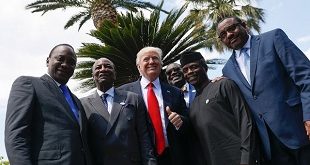By Andrew M. Mwenda
A special investigation into a joint Uganda-Kenya security hunt for terrorists
 Just before the December 20, 2010 grenade attack on a Kampala-bound bus in Nairobi, two major incidents had taken place in the Kenyan capital.
Just before the December 20, 2010 grenade attack on a Kampala-bound bus in Nairobi, two major incidents had taken place in the Kenyan capital.
First, on the morning of December 3, 2010, attackers suspected to be ethnic Somalis threw a grenade at a police patrol vehicle in Eastleigh, a city neighbourhood. The attack killed one policeman and injured several. The police pursued and killed two people it claimed were involved in the attack.
Later in the afternoon of the same day, Kenyan traffic police stopped two people on a motorbike in Nairobi on purely traffic considerations. Instead of stopping, the riding duo shot at the police, killing two officers. The police pursued them and killed two people it claimed were involved in the attack. Both were ethnic Somalis. When their bodies were searched, intelligence sources say, police picked mobile phone handsets from them.
According to Kenyan security sources, these two incidents triggered a search and cordon operation in Nairobi that led to the arrest of 183 suspects. Apparently, when police took the handsets from the two people it had killed, they retrieved previous calls made. Upon examining telephone numbers these two handsets had been calling, they were able to break into a large network of terrorists all leading to one Al Zubairi aka Godoni, the leader of Al Shabab, the Somali militant group in Mogadishu.
According to Kenyan intelligence sources, the two people on the motor bike were also found to belong to Al Shabab. The question then was: Why was Al Shabab attacking the Kenyan police when their stated enemy was the Ugandan army and government?
According to Ugandan intelligence sources, all the planning, resourcing and strategising for the July 11, 2010 Kampala bombings, the biggest such attack ever in East Africa in which over 80 people, was done in Kenya. Once the plan was done, it was only transferred to Kampala for execution.
It is, however, suspected that since the Kenyan police was critical in helping Uganda to arrest and extradite suspects, there has been growing resentment against the government of Kenya and the police specifically in Kenya’s large Muslim community generally and among ethnic Somalis specifically.
Uganda became a target of Islamic militants when it joined the US in its global war against Islamic extremism. It seems President Yoweri Museveni sought to cultivate American support by positioning himself as the promoter of US geo-strategic interests in the Great Lakes region.
It remains debatable whether the net benefits of this strategy of political consolidation on Uganda’s national interest – as opposed to Museveni’s personal political ambitions – exceed the gross costs to the country. Some analysts say that Uganda is paying too high a price for Museveni search for continued American support.
Burundi, the only other country to contribute troops to the African Union peace-keeping force in Somalia (AMISOM) has also been targeted by the Al Shabab. On December 31, 2010, just minutes before mid-night, a grenade suspected to be the handwork of Al Shabab exploded in the Burundi capital Bujumbura killing three people and injuring several.
In early September, Al Shabab issued a new threat against Uganda. The threat was renewed in early December but no incidents occurred over Christmas and the New Year.
X-mas, New Year arrests
The Independent has learnt of increased activity between the Kenyan police and intelligence services that have been working closely with their Ugandan counterparts to apprehend suspects and avert attacks.
When the two attacks against the police occurred in Nairobi, Kenyan police submitted to Ugandan intelligence all the corresponding telephone communication between the suspects in Kenya with some people in Uganda.
Two days before New Year’s Day on December 29, 2010, security at the Uganda-Kenya border at Busia arrested three suspected Al shabab operatives. They included two men, Abudala Karim and Abed Jamar Mohammed, and a woman, Abudinasia Mohammed.
 |
 |
Earlier over the Christmas season, Uganda police arrested a number of people, among them two other women and a Somali Imam of Tawfiq Mosque in Kisenyi, a low cost suburb of Kampala city. But the most important arrest was of a man only identified as Al Sahel.
Earlier still, on December 10, 2010, when a Gateway Bus Service bus bound for Kampala from Nairobi was stopped and searched by security and materials – the Koran and Somali written scripts which when read were on radicalism- the police concluded that the materials were meant for Al Sahel.
Ugandan security sources say that upon pleading from an influential Ugandan businessman of Somali descent, Ugandan police released the Imam and the two women but retained Al Sahel. When his communications were tracked, intelligence found that Al Sahel is linked to the terrorists in Kenya; especially one Hasan Yusuf Bilari and above all, to Al Zubairi aka Godoni.
Ugandan intelligence is now putting the different pieces of the puzzle together.
Hasan Yusuf Bilari had been linked to the bombing of the Kampala bound bus in Nairobi on December 20, 2010. He had been arrested by the Kenya police alongside one Abu Logo, a prominent sheik in Mombasa.
Abu Logo was also linked by Ugandan security agencies to the July 11, 2010 bombings in Kampala. However, the Kenyan government had been reluctant to arrest him largely because Logo is politically influential and the politicians did not want to risk a political backlash from their Muslim constituents.
Secondly, intelligence sources say, Kenya has a large, wealthy and well-organised Muslim and Somali community. Whenever one Muslim is attacked, they rally behind them by organising their legal defense, financial support and even mobilising their political connections to stop the process. Thus when Uganda submitted Logo’s name to the Kenyan police, little happened. But when he was linked to the killings of the Kenyan police, they had no option but to arrest the powerful sheik.
Indeed, another sheik, Mohamed Sharif, considered among the most politically powerful Muslim clerics in Kenya was also arrested in connection to growing Islamic militancy in the country. This showed that the Kenyan government was beginning to find political courage to take on politically sensitive issues.
 The mid-December 2010 visit to Uganda by Kenyan Prime Minister, Raila Odinga, who is strong in Kenya’s coastal region which is largely dominated by Muslims, appears tohave been partly due to the growing convergence of interests between him and President Yoweri Museveni in regard to combating Islamic extremism. Odinga and Museveni reportedly also discussed the International Criminal Court indictment of six senior Kenyan politicians.
The mid-December 2010 visit to Uganda by Kenyan Prime Minister, Raila Odinga, who is strong in Kenya’s coastal region which is largely dominated by Muslims, appears tohave been partly due to the growing convergence of interests between him and President Yoweri Museveni in regard to combating Islamic extremism. Odinga and Museveni reportedly also discussed the International Criminal Court indictment of six senior Kenyan politicians.
The challenge for Odinga, experts say, is whether he can afford to politically alienate the powerful Islamic political interests in the coastal region.
Threats real
Concern is high in Uganda’s intelligence services that a terrorist attack is still possible in the country.
On July 11, 2010, the day of the terrorist bombing of Kampala, security agencies retrieved a phone handset from a suicide jacket that had failed to explode in Makindye. According to a classified memo from the Joint Anti-Terrorism Taskforce (JATT), the phone, a Nokia series 1208, was attached to the suicide jacket as a detonator. Security agencies retrieved the sim card and began to follow leads.
JATT has over the years of fighting terrorism developed critical phone tracking systems. This system has been successfully used to build a communication matrix for the Allied Democratic Forces (ADF) terrorist group. This Matrix (see graph on page 15) allows JATT to track down the entire communication infrastructure of the rebels first, and then begin eliminating them one by one.
According to the classified memo, when the phone was retrieved, JATT went to work. They collected phone records from MTN and traced the persons whom that phone network had called. Among them was a lady called Ida Nabwami running a lock-up shop at Pioneer Mall; her phone number was found to have links with a serial number on the Makindye phone. She was the first person to be arrested and taken to JATT headquarters on Summit View, Kololo.
 According to security sources, JATT soon found out that Nabwami was not directly involved in terrorism activities even though the terrorists were in contact with her. Apparently, she was employed by one Haruna Luyima, brother of Isa Ahmed Luyima, the suspected leader of the 7/11 bombings. Haruna had employed her as a shop attendant. JATT asked her for the names of the people she had been communicating with on telephone. She was cooperative and revealed all of them to security.
According to security sources, JATT soon found out that Nabwami was not directly involved in terrorism activities even though the terrorists were in contact with her. Apparently, she was employed by one Haruna Luyima, brother of Isa Ahmed Luyima, the suspected leader of the 7/11 bombings. Haruna had employed her as a shop attendant. JATT asked her for the names of the people she had been communicating with on telephone. She was cooperative and revealed all of them to security.
According to sources inside the interrogation room, JATT officers realised that she actually did not know what was taking place. She was released. Meanwhile, the Federal Investigations Bureau (FBI) officers from the United States who had come to Uganda after the bombings to help in the investigations had returned home. Upon hearing of this progress, the FBI got excited and returned to Uganda immediately.
Security had already established that the lead terrorist in the bombings was not a Somali, but a Ugandan Muslim called Issa Ahmed Luyima. The people whose names Nabwami revealed to security as calling her were brothers of Luyima. JATT positioned its agents around Pioneer Mall and Wilson Street when both of them were later picked and taken for interrogation. One by one, more terrorists were arrested and interrogated.
Many suspects were arrested. During the interrogations, security had learnt that terrorists had prepared 12 bombs but used only four. Eight were still unaccounted for.
Till today, security has failed to locate them. In his confessions one of the terrorists had confirmed that he had seen the bombs and tried some of them on his chest in a terrorist safe house in Najanankumbi along Entebbe Road in Kampala. The concern of the Joint Intelligence Committee (JIC) has since then been to find these bombs.
 Ugandan security is concerned that, according to the interrogation transcripts, the explosives had been brought into Uganda through Malaba and driven across the border in a Toyota Land Cruiser without being caught.
Ugandan security is concerned that, according to the interrogation transcripts, the explosives had been brought into Uganda through Malaba and driven across the border in a Toyota Land Cruiser without being caught.
“This brings into question the effectiveness of border security to deter terrorism,” an August Uganda Security assessment report says.
Apparently, security officials believe that the unused explosives are still inside Uganda; they are the major source of Al Shabab’s confidence. Security officials say they are likely to be deployed with devastating effect.
Information from the interrogations shows that some of the terrorist involved in masterminding the bombings went missing and security has not tracked anyone of them down since September. Also, the vehicle that brought the explosives into the country was impounded from Kenya, showing that it had been able to drive back into the country. However, the driver of the vehicle is still missing as is one of the major coordinators of the attacks.
The real problem with border security in Uganda, security officials say, is that its officials are trained mainly to verify travel documents only. This is a major weakness given that terrorists often travel on valid travel documents.
“Tax officials at the border are purely concerned with revenue collection, not with national security threats,” the assessment report said, “The explosives that killed so many people passed through the border without any question. It is possible that revenue officials looked at them and concluded that these items were none taxable. The challenge is to integrate tax administration and security vigilance.”
Terrorists exposed
Those arrested also revealed how the bombings were organised and the entire chronology of the bombing plan. They also revealed a lot about what they planned to do next. According to records of the interrogation, copies of which The Independent has seen, the terrorists said they had planned to hijack planes and crash them into Kampala; specifically into Entebbe International Airport, State House Entebbe, the American Embassy, the British High Commission, security installations and other diplomatic missions especially those of Western countries in Kampala.
 According to the interrogation transcripts, the terrorists had planned to hijack planes coming in from Juba enroute to Nairobi and Kampala because the airport in Juba has less rigorous security measures. They said they could not succeed to hijack a plane from Kenya, Tanzania or Rwanda because of the more elaborate and effective security measures.
According to the interrogation transcripts, the terrorists had planned to hijack planes coming in from Juba enroute to Nairobi and Kampala because the airport in Juba has less rigorous security measures. They said they could not succeed to hijack a plane from Kenya, Tanzania or Rwanda because of the more elaborate and effective security measures.
In a report to President Yoweri Museveni and later in their own internal security assessments, security organs argued that the challenge in fighting an asymmetric war against terror is the difficulty of being able to establish exactly when and where the terrorists would strike.
As a result, security at the airport was heavily reinforced; cars were stopped from driving up to the departure’s area for fear of terrorists driving a truck into the check-in counters at the airport. Security also began checking bags of people entering the country from abroad.
It is in this context that changes within Uganda’s security organisations began in earnest. President Museveni fired the Director General of Internal security organization (ISO), Amos Mukumbi, as the first step in solving the crisis in security. In an interview with The Independent at State House Entebbe in September, the President confirmed that he had fired Mukumbi because “that man had literally killed ISO, an entire national institution was almost dead. Now our challenge is to resuscitate it.”
From July, funding for security agencies increased for both operations and staff welfare. Sources inside security now say morale is high.
The interrogations also revealed that terrorists are getting money from religious extremist groups across the Muslim world. Secondly, the people responsible for transferring monies were not Ugandans, not even ethnic Somalis but Kenyans. This has added a major twist to the problem as one would have expected the terrorists to be ethnic Somalis. Has Al Shabab decided to outsource terrorists or is it supported by a widespread network of Islamic extremists?
For example, Ugandan security sources say that Isa Luyima is highly “radicalised.” He fought UPDF alongside Al Shabab in Mogadishu together with one Mugisha, a Rwandese by ethnicity and one of the leading Islamic militants responsible for the 7/11 bombings in Kampala. It is Mugisha who in his confession talked about the training of pilots by Al Shabab among Somalis in the Diaspora, especially Sweden, to crash planes at targets in Entebbe and Kampala.
In June 2010, Senegalese Security in Dakar had arrested four Moroccans going to the Democratic Republic of Congo. Later it was found that they were headed to the eastern town of Beni where they planned help build the capacity of the Allied Democratic Front (ADF) rebels there. ADF rebels belong to the Salaaf sect of Islam as do the leaders of the Al Qaeda. These pieces of information have cast significant light on the extent of the terrorist problem Uganda faces.
 The Independent Uganda: You get the Truth we Pay the Price
The Independent Uganda: You get the Truth we Pay the Price



